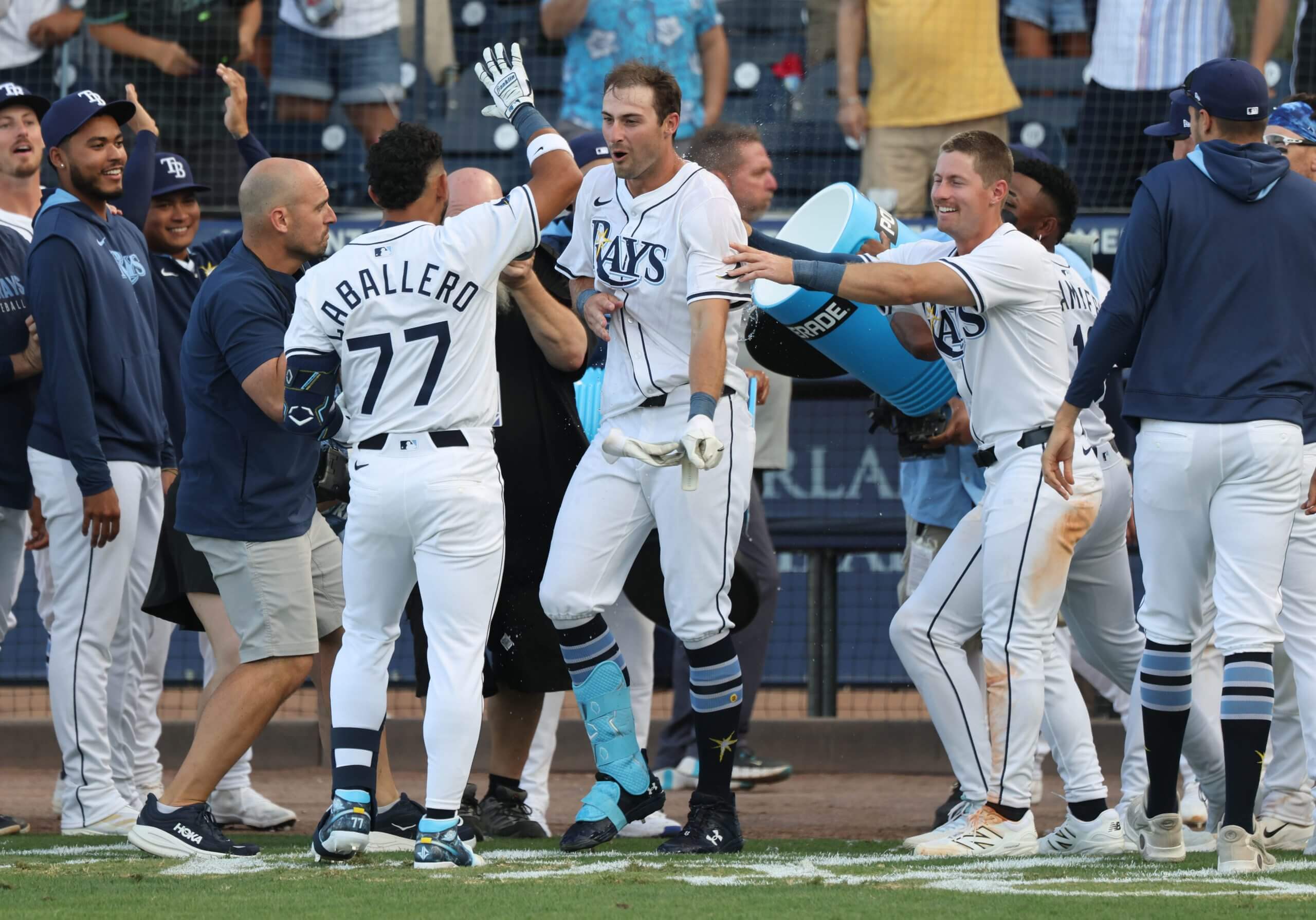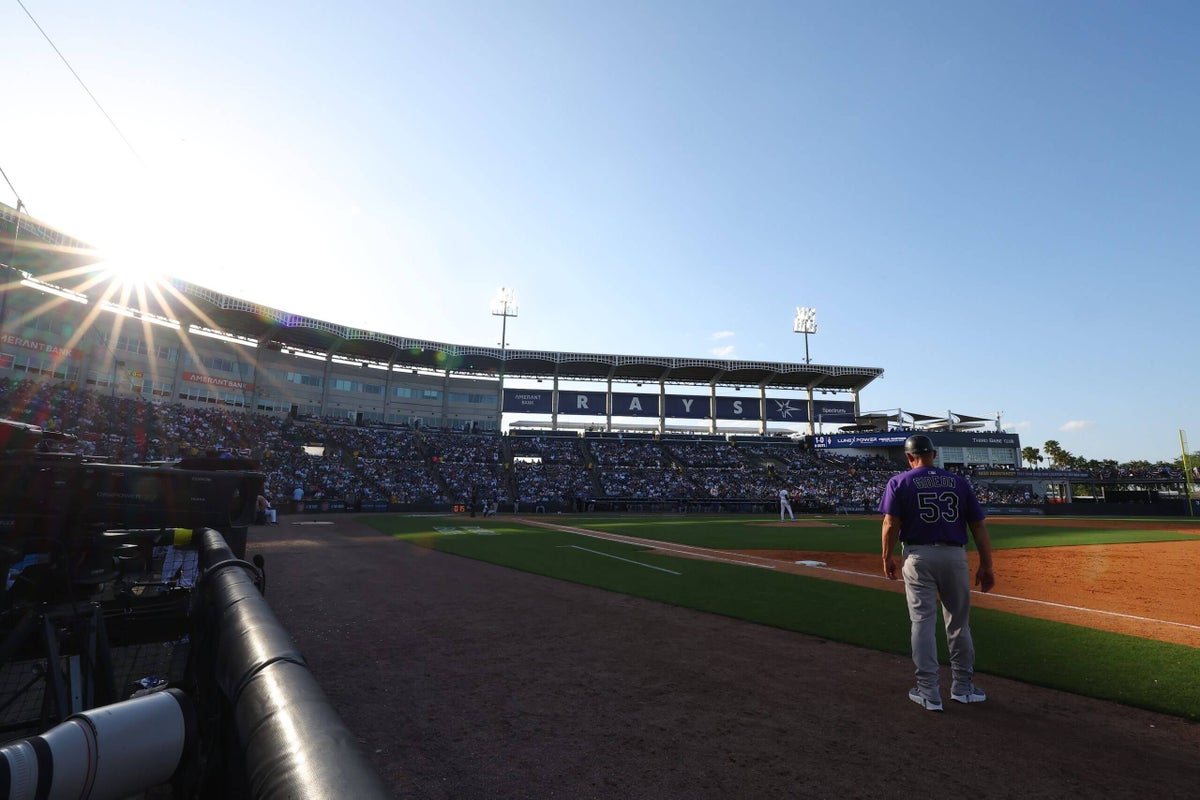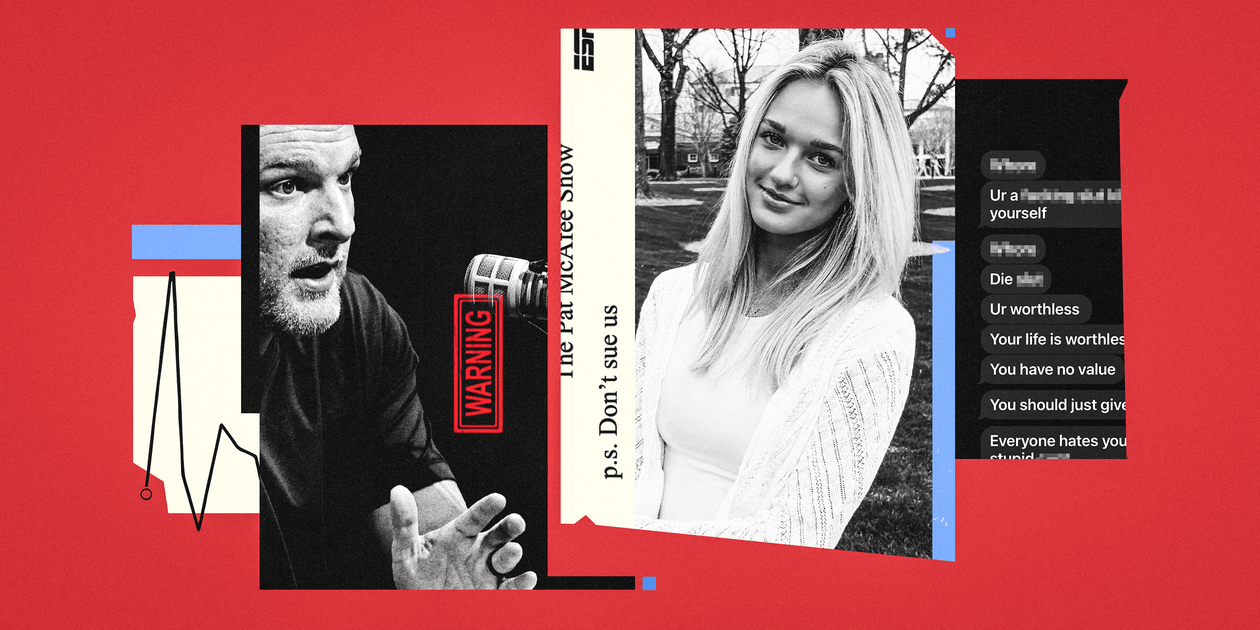Rays Embrace New Beginnings at Steinbrenner Field

TAMPA — For two decades, Dan Moeller has understood a crucial lesson that the younger members of his staff are about to discover: when it comes to pulling a tarp over a rain-soaked infield, it’s best to start from the corners. Those who opt to pull from the middle often find themselves tripping, slipping, and potentially ending up underneath the heavy tarp. Moeller, who serves as the director of projects and field operations for the Tampa Bay Rays, knows this all too well. “You really feel it in your hamstrings,” he remarked with a knowing smile.
Moeller oversees the team’s dedicated grounds crew, consisting of seven full-time employees and eight part-time workers. Just 32 minutes before the first pitch on Friday, the crew gathered on the infield grass to witness one member expertly spray a vibrant yellow sunburst logo on the back of the mound. This moment was particularly significant, as it marked the first time the logo represented more than just the franchise’s name; the Rays were genuinely playing baseball in the sun.
Friday’s season opener at George M. Steinbrenner Field was nothing short of triumphant. Following the destruction caused by Hurricane Milton, which damaged the roof of Tropicana Field six months earlier, the Rays now had a new home. The stadium had undergone a remarkable transformation, adorned with Rays signage, and the weather was perfect—84 degrees with a gentle breeze blowing towards left field. Ryan Pepiot delivered an impressive six innings on the mound, while a dramatic two-run rally tied the game in the seventh. In a thrilling finish, Kameron Misner, a 27-year-old making his debut on Opening Day, hit a walk-off homer in the ninth inning, sealing a 3-2 victory. This event was a testament to the organization’s adept problem-solving and late-game execution, leaving the Rays with an undefeated record.
However, as joyous as the victory was, the real challenges lie ahead. The Rays must now acclimate to the intense Florida humidity that leaves infielders dripping with sweat, and outfielders battling the wind in an open-air stadium devoid of a third deck. Starting pitchers will face the grueling heat as they attempt to pitch through six innings, while the coaching staff will be on high alert for potential rain delays and the dreaded prospect of doubleheaders that could wreak havoc on the bullpen. Steinbrenner Field promises to be unlike any other venue in baseball this summer.
“We want to create a home-field advantage with that,” said Rays manager Kevin Cash. “I’d love to look up in two or three weeks, when the heat of summer kicks in, and see that we’re thriving while other teams are complaining about it.”
Moeller is not interested in hearing any complaints. The dimensions of the field remain unchanged; the mound is still 60 feet, six inches from home plate, and the bases are still 90 feet apart. But the transition from maintaining artificial turf in a climate-controlled environment to caring for a natural grass field under the blazing sun presents a significant challenge.
Moeller and head groundskeeper Mike Deubel are well aware of the misconceptions surrounding their work at Tropicana Field—many assume they’ve simply been managing carpet. This stereotype is not only inaccurate but also quite unfair. “Do you know how to maintain moisture in infield dirt that’s constantly being sucked dry by the concrete beneath it and the air conditioning above?” Moeller asked. “It’s no small feat.”
Now, they face the daunting task of managing natural grass in a notoriously unpredictable climate that can swing from scorching heat to sudden downpours in an instant. While Moeller and Deubel have experience working outdoors, many of their staff members are in for a crash course in patience, precision, and the discomfort of wet socks. Moeller has even increased his budget to provide extra uniforms so that his crew can change when they inevitably get soaked by a passing shower. To further prepare, he sent most of his crew to work for the Yankees during spring training to learn firsthand how to maintain a field in such conditions, with some Yankees staff even staying on to assist.
The Rays’ crew got some practice pulling the tarp a couple of times during spring training, but they have yet to face the challenge of doing so in the middle of the eighth inning, with Pete Fairbanks warming up in the bullpen and the rain unexpectedly turning into a downpour. They haven’t experienced the chaos of pulling the tarp while already drenched, late at night, with no clear idea of when they might finally head home. “Welcome to the big leagues,” Moeller quipped, acknowledging the steep learning curve ahead.
This sentiment applies to the Rays players as well. While many have experienced the big leagues before, they have never faced a season like this one. Pepiot has taken extra precautions to acclimate to the heat, spending more time in the sauna, enjoying post-workout hot tub sessions, and going on walks with his wife to help his body adjust. “No one is ever going to get used to 105 degrees with unbearable humidity,” he admitted. “But I’m trying to become a little more accustomed to it.”
The Rays also assessed their players’ sweat levels during spring training—second baseman Brandon Lowe is classified as a Tier 2, moderate sweater—and used this data to create tailored hydration plans for each player. Shortstop Taylor Walls, however, who hails from Georgia and played college ball at Florida State, believes the heat and humidity will be manageable over nine innings. His main concern lies with the rain; should the notorious Gulf Coast showers linger, they could lead to game cancellations, and doubleheaders in this climate would be particularly grueling.
Cash shares this concern. He can manage players’ pregame activities to ensure they are well-rested, and he can keep them hydrated, but doubleheaders pose a significant challenge, especially for the pitching staff. While Steinbrenner Field features misters in the dugout for fan comfort, there’s little to mitigate the impact of rain.
To accommodate the unpredictable Florida weather, Major League Baseball has adjusted the Rays’ schedule. The team is set to play 19 home games between March 28 and April 20, which accounts for nearly a quarter of their home schedule before summer officially arrives. The tradeoff is that they will have only 12 home games from June 23 to August 18. Consequently, they are scheduled to spend much of August on a two-week, four-city West Coast road trip, which includes a stop in Sacramento to play the Athletics at the other minor league ballpark hosting Major League games this season.
With sun, rain, wind, and shadows at home, coupled with longer-than-usual road trips, the Rays are stepping into uncharted territory. Yet, they emerged victorious on Opening Day, buoyed by a strong pitching staff and a deep bench, suggesting that perhaps this season won’t be so different after all. “There are a lot of differences,” Cash acknowledged. “But now we can take a breath and spend hours brainstorming how we can turn these challenges into our advantage.”
(Top photo of Steinbrenner Field on Friday: Mike Carlson/MLB Photos via Getty Images)

